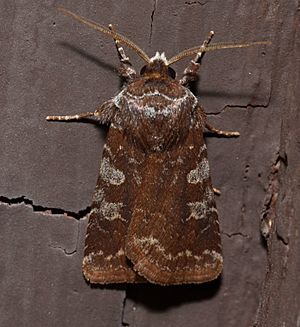Cerastis tenebrifera facts for kids
The reddish speckled dart (Cerastis tenebrifera) is a type of moth that belongs to a large family called Noctuidae. These moths are often active at night. This particular moth gets its name from its reddish color and small speckles on its wings.
Quick facts for kids Cerastis tenebrifera |
|
|---|---|
 |
|
| Scientific classification | |
| Kingdom: | |
| Phylum: | |
| Class: | |
| Order: | |
| Family: | |
| Genus: |
Cerastis
|
| Species: |
C. tenebrifera
|
| Binomial name | |
| Cerastis tenebrifera (Walker, 1865)
|
|
| Synonyms | |
|
|
Contents
About the Reddish Speckled Dart Moth
The reddish speckled dart is a fascinating insect from the Noctuidae family. Moths in this group are sometimes called "owlet moths." They are known for their sturdy bodies and often dull, camouflaged colors.
Where Does It Live?
You can find the reddish speckled dart moth across a wide area of North America. Its home ranges from Newfoundland in the east, all the way down to South Carolina. It also lives west to Texas and north to Nebraska and southern Ontario in Canada.
What Does It Look Like?
This moth is not very big. Its wingspan is usually between 30 and 40 millimeters. That's about the length of two standard paper clips placed end-to-end. The wings have a reddish color with small, scattered speckles.
When Is It Active?
Adult reddish speckled dart moths are usually seen flying from early spring to early summer. They are active from March through June. During this time, they are busy finding mates and laying eggs.
What Do They Eat?
Like all moths, the reddish speckled dart starts its life as a larva, also known as a caterpillar. These caterpillars eat leaves from various plants. Scientists have observed them feeding on:
- Lactuca (like wild lettuce)
- Vitus (grape vines)
- Taraxacum officinale (dandelions)
- Rubus idaeus (red raspberries)
- Salix petiolaris (willows)
- Prunus virginiana (chokecherries)
- Betula papyrifera (paper birches)
- Vaccinium myrtilloides (velvetleaf blueberries)
This wide variety of food sources helps the caterpillars grow strong before they turn into adult moths.

